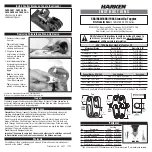
D-160 Owner's Manual (Before operating the D-160)
33
cartridge.) This means that you can record total 240 minutes of data with a sampling
rate of 44.1kHz in a single track.
Recording one-minute, one-track data with a sampling rate of 44.1kHz on the D-160
requires approximately 5.3MB of hard disk space. Therefore, the amount of space required
for a particular recording should be obtained by multiplying 5.3MB by the number of
tracks by the number of minutes (duration). If the REMAIN display indicates 240 minutes
based on a mono track, you can record about 15 minutes of 16-track data. If you have
recorded 10 minutes of 16-track data, you would have used the hard disk space
corresponding to 160 minutes (16 tracks times 10 minutes). The resultant REMAIN value
would be 240 -160 = 80 minutes.
2. Audio file and Event
As described in the previous section “Hard disk recording method and the REMAIN
display,” the basic recording method differs between the D-90/D-80/DMT series and D-
160. The D-160 contains sequential individual audio files recorded in the tracks of a
Program. You can insert silence between these audio files. The silence will be counted as
a zero file. As shown in the diagram below, audio files and zero (0) files will be recorded
alternately.
“The number of events” of a certain track is calculated by adding up the number of these
audio files and zero files. Each track can contain up to 512 events, but the D-160 will not
record new data when the recording reaches the event 508.
Usually, a single event is created by one recording or editing operation, and the number
of the events changes according to the edit point or the amount of available disk space.
(The D-160’s disk management generally tries to reduce the number of events.)
This does not create problems in most music production. However, if you make frequent
recordings with zero files in between the audio files, the number of the events could
exceed the limit. In order to prevent this, you need frequently to check the number of
events on each track during a session.
Use the “NOs Of Event?” menu in Setup mode to check the number. Refer to “‘NOs Of
Event?’ menu in Setup mode” on page "163."
<Note on Digital In recording>
No “0 file” is created during analog recording, because data 0 will not continue even when
silence is being recorded. On the other hand, if you are recording data via S/P DIF or adat
input, the D-160 will create a zero file when 0 data is consecutively input for one second to
save disk space. This increases the number of events. Watch out for “the excessive number
of events.”
What is an event?
As shown in the diagram below, the number of events can be eleven or more if partial
recordings are made. This is because an unrecorded part is regarded as an event, and a
recorded part is also regarded as an event(s). The duration of each event can vary from
740 msec to 23 hours 59 minutes 59 seconds (FS = 44.1kHz).
Recorded part (shortest: 740 msec, FS=44.1kHz)
Unrecorded part (shortest: 740 msec, FS=44.1kHz)
ABS 23h 59m
0
1
4
9
10
ABS 0
2
3
5
6
7
8
11
ABS END
Audio File 1
Audio File 2
0 File 1
Audio File 3
0 File 2
Audio File 4
ABS 0
ABS END
No sound
No sound
















































